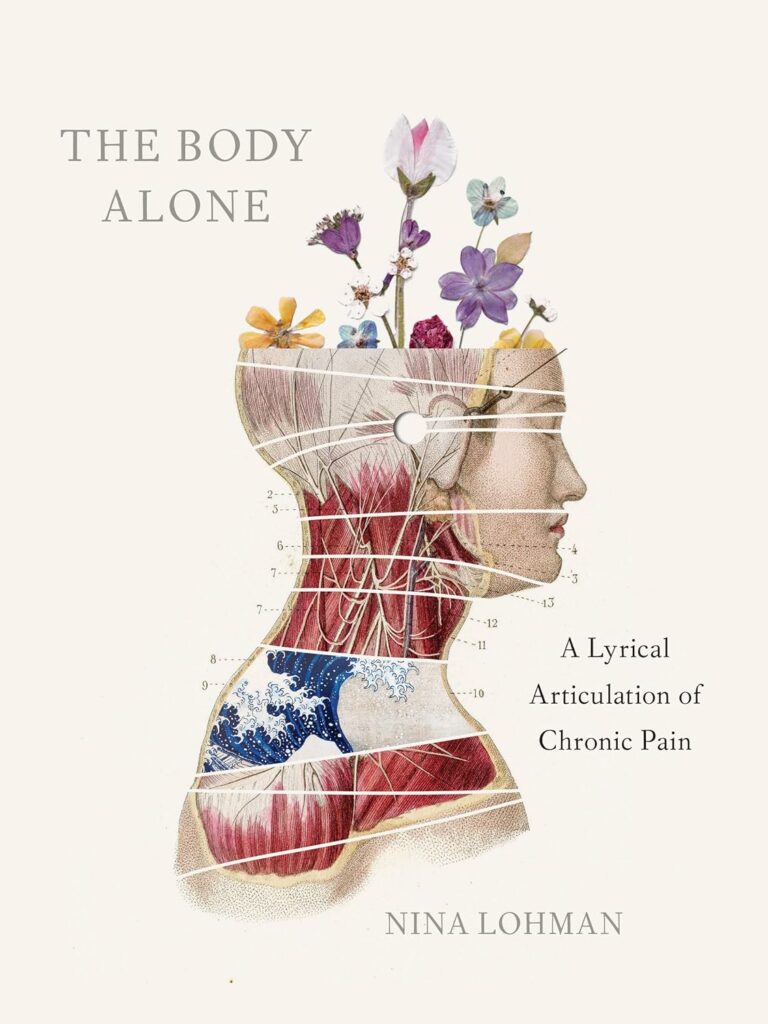Reviewed by Sara Pisak
 “How much pain can you handle?”
“How much pain can you handle?”
“How much pain can you handle?”
“How much pain can you handle?” (71, 141, 223).
Repeated multiple times throughout Nina Lohman’s The Body Alone: A Lyrical Articulation of Chronic Pain, this question guides the narrative, both interrupting and driving it forward. Lohman a scholar of theology and lover of myths, writes her own life story with the authenticity and aura of the texts and oral traditions she studies and admires.
As someone who lives with chronic pain caused by headaches, Lohman’s nonlinear narrative follows the ever-looping cycle of the healthcare system, chronic pain symptoms, and searching for a diagnosis. On the topic she writes:
My story, like pain itself, swivels erratically—often without warning at all. You’ll need to pay close attention to keep up. It loops back right when you expect it to tumble forward. It pauses unpredictably then stays in the same place, stunted and sweaty, awkwardly, sometimes you won’t believe how long it is possible for one thing to sit in the same place, but it does, stuck, oh my god we are still here, stuck, for far too long. I’ll need you to be patient. The chronology of pain is circuitous (7).
Within these narrative twists and turns, Lohman includes blackout poetry-style and dictionary style entries. But don’t confuse the twists and turns with lack of clarity or difficulty to understand. Lohman is very clear and concise. She makes a self-aware, conscious craft choice to have the narrative be circular, repetitive, and interrupting at times to showcase the true nature of pain. By the time this quote appears seven pages in, the reader knows that the narrative is about pain; however, Lohman’s direct reference to the structure clearly paints the narrative structure to be equivalent to pain.
Directly referencing the structure as a reflection of pain is vital to Lohman and the narrative. Pain as an abstract is difficult for people to comprehend. Convincing someone of the legitimacy of pain is an uphill battle people with chronic pain and the disabled face, whether they are writers or not. She states, “That means the reality of pain hinges on the sufferer’s ability to convince others of its existence. I’ll say that again. The sufferer must prove pain for its legitimacy to be accepted (53).” By using the narrative structure as an overarching metaphor for pain, Lohman challenges the status quo that pain must be visible, acknowledged by others, or meet an ableist cliché in order to exist.
Pain does exist without acknowledgment from others or a medical diagnosis. A reader comes to realize that Lohman’s experience may be niche and specific to her, but it is not a singular experience. Instead, this narrative resonates with many because within The Body Alone we learn that three million Americans have chronic pain. This is a simple fact Lohman teaches the reader. But the larger payoff is the power of putting pain on trial and at times the overall healthcare system to prove pain’s existence beyond a reasonable doubt. This is something Lohman shouldn’t have to do, but in doing so, she gains control over her narrative without others asserting their own narrative control.
In the trial that pain exists, Lohman presents facts for consideration regarding pain such as, pain’s three components: sensory, emotional, and cognitive. She also devotes sections to pain medicines and treatments. noting that many pain meds are tested only on men and viable treatments for women can be discarded in clinical testing because they were ineffective for men.
The verdict is that power comes from naming, knowing, and classifying pain. This simultaneously echoes the mythology of pain and demystifies it. And as a scholar of theology and myths Lohman reflects:
My pain remains nameless.
I think of the Egyptian deity Ptah who possessed the power to create anything that he could first name. I think of the miller’s daughter who claimed agency over her fate only after she learned the name of the imp Rumpelstiltskin. I think of how Adam was given the responsibility of naming cattle, naming birds, naming each paraded animal. In these stories, these metaphors of power and domination, we transform the mysterious into the known. If doctors can’t and won’t, what name will I give this pain? (75).
Naming to gain agency over one’s self, condition, pain, and narrative are as old as folklore, Egyptian pharaohs, and Biblical times. Lohman uses the very system of medical facts and figures that discounts her pain and won’t name or recognize it to give meaning to her story. She takes the responsibility of Adam, Ptah, and the miller’s daughter into her own hands and succeeds where the healthcare system fails. Lohman concludes, “This my story now, my myth. I will write a twisted meaning into my pain (201).”
With The Body Alone, Lohman adds to the rich literary tradition of naming and writing her own myth and pain origin story.

Sara Pisak
Community Content EditorSara Pisak is a reviewer, essayist, and poet. Sara participates in the Poetry in Transit Program and has work in The Rumpus, The Fourth River, LandLocked, Hippocampus, the Deaf Poets Society, Door is a Jar, and Appalachian Journal, among others. In total, she has published over 130 pieces. When not writing, Sara can be found spending time with her family and friends.
Role: As community content editor, Sara creates written and visual content for Hippocampus social channels and website, helping promote our magazine and uplift our contributors.



Thanks for this review. Sounds intriguing.